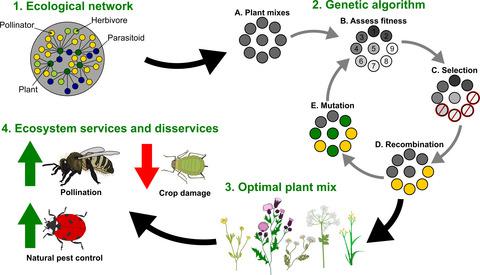当前位置:
X-MOL 学术
›
J. Appl. Ecol.
›
论文详情
Our official English website, www.x-mol.net, welcomes your feedback! (Note: you will need to create a separate account there.)
Identifying plant mixes for multiple ecosystem service provision in agricultural systems using ecological networks
Journal of Applied Ecology ( IF 5.7 ) Pub Date : 2021-09-01 , DOI: 10.1111/1365-2664.14007 Fredric M. Windsor 1 , Julia Tavella 2 , Débora C. Rother 3 , Rafael L.G. Raimundo 4 , Mariano Devoto 2 , Paulo R. Guimarães 3 , Darren M. Evans 1
中文翻译:

使用生态网络识别农业系统中提供多种生态系统服务的植物组合
更新日期:2021-09-01
Journal of Applied Ecology ( IF 5.7 ) Pub Date : 2021-09-01 , DOI: 10.1111/1365-2664.14007 Fredric M. Windsor 1 , Julia Tavella 2 , Débora C. Rother 3 , Rafael L.G. Raimundo 4 , Mariano Devoto 2 , Paulo R. Guimarães 3 , Darren M. Evans 1
Affiliation

|
- Managing agricultural environments in a way that maximises the provision of multiple ecosystem services is a significant challenge in the development of sustainable and secure food systems. Advances in network ecology provide a way forward, particularly in arable landscapes, as they incorporate mutualistic and antagonistic interactions associated with crop production.
- Here, we present an approach to identify mixes of non-crop plant species that provide multiple ecosystem services while minimising disservices. Genetic algorithms were applied to the Norwood Farm ecological network—a comprehensive dataset of antagonistic and mutualistic species interactions on an organic farm in the United Kingdom. We aimed to show how network analyses can be used to select plants supporting a high diversity of insect pollinators and parasitoids of insect pests, but low diversity of herbivores. Further to this, we wanted to understand the trade-offs in ecosystem service provision associated with conventional management practices that focus on individual ecosystem services.
- We show that multilayer network analyses can be used to identify mixes of plant species that maximise the species richness of pollinators and parasitoids (natural enemies of insect pests), while minimising the species richness of herbivores.
- Trade-offs between ecosystem processes were apparent with several plant species associated with a high species richness of both positive (pollinators and parasitoids) and negative (herbivores) functional taxonomic groups. As a result, optimal plant species mixes for individual ecosystem services were different from the mix simultaneously maximising pollination and parasitism of pest insects, while minimising herbivory.
- Synthesis and applications. Plant mixes designed solely for maximising pollinator species richness are not optimal for the provision of other ecosystem services and disservices (e.g. parasitism of insect pests and herbivory). The method presented here will allow for the design of management strategies that facilitate the provision of multiple ecosystem services. To this end, we provide a protocol for practitioners to develop their own plant mixes suitable for farm-scale management. This avenue of predictive network ecology has the potential to enhance agricultural management, supporting high levels of biodiversity and food production by manipulating ecological networks in specific ways.
中文翻译:

使用生态网络识别农业系统中提供多种生态系统服务的植物组合
- 以最大限度地提供多种生态系统服务的方式管理农业环境是发展可持续和安全的粮食系统的重大挑战。网络生态学的进步提供了一条前进的道路,特别是在可耕地景观中,因为它们结合了与作物生产相关的互惠互利的相互作用。
- 在这里,我们提出了一种方法来识别提供多种生态系统服务同时最大限度地减少损害的非作物植物物种的混合。遗传算法被应用于诺伍德农场生态网络——英国一个有机农场对抗和互惠物种相互作用的综合数据集。我们旨在展示如何使用网络分析来选择支持昆虫传粉媒介和害虫寄生蜂高度多样性但食草动物多样性低的植物。此外,我们想了解与专注于单个生态系统服务的传统管理实践相关的生态系统服务提供的权衡。
- 我们表明,多层网络分析可用于识别植物物种的混合,最大限度地提高传粉媒介和寄生蜂(害虫的天敌)的物种丰富度,同时最大限度地减少食草动物的物种丰富度。
- 生态系统过程之间的权衡很明显,几个植物物种与阳性(传粉者和寄生蜂)和阴性(食草动物)功能分类群的高物种丰富度相关。因此,单个生态系统服务的最佳植物物种组合不同于同时最大限度地提高害虫授粉和寄生性,同时最大限度地减少食草性的组合。
- 合成与应用。专为最大限度地提高传粉媒介物种丰富度而设计的植物混合物对于提供其他生态系统服务和损害(例如害虫和食草动物的寄生)而言并不是最佳的。这里介绍的方法将允许设计管理策略,以促进提供多种生态系统服务。为此,我们为从业者开发适合农场规模管理的自己的植物组合提供了一个协议。这种预测网络生态学的途径有可能通过以特定方式操纵生态网络来加强农业管理,支持高水平的生物多样性和粮食生产。



























 京公网安备 11010802027423号
京公网安备 11010802027423号